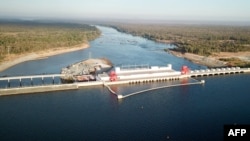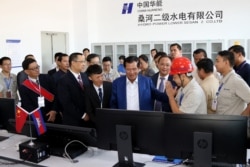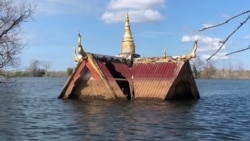The construction of the Lower Sesan II dam in Stung Treng province – which has been operational since December 2018 – has wreaked havoc on indigenous and ethnic minorities, according to a new report from Human Rights Watch.
The U.S.-based rights group Human Rights Watch released the “Underwater: Human Rights Impacts of a China Belt and Road Project in Cambodia” Tuesday morning that documents ownership and construction of the controversial 400-megawatt dam, rights violations and the lives of ethnic and indigenous groups displaced by the dam’s reservoir. The rights group used 60 interviews with affected residents academic and local NGOs, business records and documents and other available resources to compile the report.
The project is supposedly under the Belt and Road Initiative (BRI), an investment vehicle used to pursue China’s foreign policy interests, though no official classification or list has been seen of BRI projects. The Sesan II dam was built by China Huaneng Group, with a 51 percent majority holding, Cambodian firm Royal Group and a Vietnamese state-owned utility company.
The report says that nearly 5,000 people belonging to the Bunong, Kuoy, Lao, Jarai, Kreung, and Tampuon ethnic and indigenous minorities, among other groups. These minority groups are native to the area and have close connections to the land and Sesan and Sreypok rivers.
“In addition, the project impacted tens of thousands of other people upstream and downstream of the dam who depended on the rivers’ fisheries for food and income,” the report reads.
“The project has also likely contributed to decreases in fishery yields across the entire Mekong River system, which is significant since tens of millions of people in Cambodia, Vietnam, Thailand, and Laos depend on fish caught in the Mekong system for food.”
Cambodia approval for the project has been criticized for the disproportionate impact it has had on groups living in the area, as well the environmental impact of the dam especially on the fish population. The project was also plagued with widespread deforestation around the proposed reservoir.
Prime Minister Hun Sen and his government downplayed the environmental impact and approved the $816-million project. But, a leaked government-commissioned study had warned of a devastating impact on the Mekong’s fisheries and ecosystem. Fish stocks were expected to drop 9.3 percent across the Mekong Basin, according to a study by the Proceedings of the National Academy of Sciences in the U.S.
VOA stories have documented the upheaval faced by local communities who have seen their livelihoods and lifestyles upended by the rising waters of the Sesan II reservoir. The ethnic and indigenous minorities place high cultural and religious significance on certain forestland and burial grounds.
A majority of villagers accepted meager compensation packages and moved to relocation sites with little to no chance of earning a living – leaving behind their ancestral lands and gravesites that are now submerged underwater.
Few villagers have rejected compensation and settled at the reservoir’s banks wanting to stay close to their ancestral lands, according to reportage from VOA Khmer, with sections of the Cambodian government claiming the holdouts were starting a secessionist movement which was quickly rejected by communities.
Sraing Lanh, 44, a Bunong indigenous villager from Kbal Romeas in Stung Treng, told VOA Khmer last week that around 230 villagers had decided not to go to the relocation site provided by the government because they wanted to stay close to their now-submerged village.
“If we go to settle near the national road, we don’t know what to do since we are indigenous people who do farming and live our life in natural forests,” said Sraing Lanh, a mother of three.
“Some villagers agreed to [take compensation] and some have not. I want to live on my ancestral land and maintain the waters, forests through collective ownership based on the traditions of indigenous people,” she added.
Villagers want the government to formalize the land they live, she said, but had little hope authorities would comply with their demands.
Fut Kheun, 40, an ethnic Kreung villager, is part of 60 families that have rejected government compensation offers and chosen to remain close to their ancestral lands and worried that they could be evicted at any time.
“We will develop a new village by ourselves … but we just asked the government to recognize us as the victims of the large development. We asked to establish new village [with roads and schools],” he said.
Human Rights Watch’s Asia advocacy director, John Sifton said the government needed to urgently revisit compensation, relocation and livelihood restoration mechanisms offered to communities so that the same mistakes were would not be repeated with other projects.
“The Lower Sesan 2 dam washed away the livelihoods of Indigenous and ethnic minority communities who previously lived communally and mostly self-sufficiently from fishing, forest-gathering, and agriculture,” said Sifton.
Victor Jona, a spokesperson at the Ministry of Mines and Energy, refused to comment on the report asking VOA Khmer to submit a written request for comment. (Victor Jona has responded to VOA queries on multiple occasions in the past without a written request.)
Previously, Jona has commented on the Sesan II controversy, claiming that indigenous villagers simply had to make way for development and were being taken care of at the relocation site. He suggested that the number of families refusing compensation was dropping and the holdouts should settle for the government’s offer.
Jun Hui He, a communications officer at China Huaneng’s Cambodia office, also refused to comment on the report and directed queries to the Cambodian and provincial authorities.
“I am not authorized to respond because we have a lot of work to do, the real work in hydropower, producing electricity for Cambodia,” Hui He said.
“The [Cambodian government] have the responsibility to respond. It is not the company’s duty to respond,” he said.












